Root 2 is irrational - proof by the carpets theorem
Categories: number theory

In the article Root 2 is irrational - proof by prime factors, we used proof by contradiction to prove that the square root of 2 is irrational. In this article, we will take a similar approach, but we will use the carpets theorem rather than analysing prime factors. This makes for a much simpler proof.
Carpets theorem
Suppose you have a room where the floor is completely covered by two non-overlapping carpets. The red carpet covers area X, and the blue carpet covers area Y. Between them, they exactly cover the whole floor:
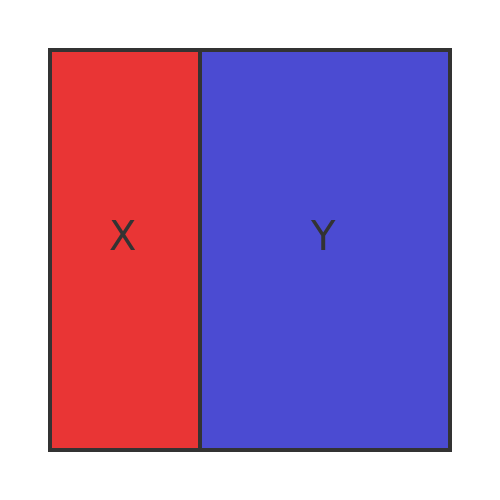
Now, suppose we move one of the carpets so that it partly overlaps the other carpet. This will leave part of the floor with no carpet:
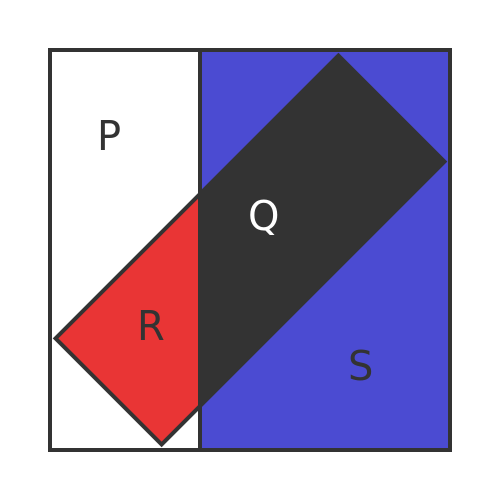
Here, R is the area covered only by the red carpet, and the entire blue area S is covered only by the blue carpet. Q is the area where the two carpets overlap, and the entire white area P is the part of the floor that has no carpet.
The carpets theorem says that the uncovered region P has exactly the same area as the overlapping region Q.
You might regard that as self-evident. Any part of the red carpet that isn't covering the floor must overlap the blue carpet, so those areas must be equal.
But if you need proof, it is easy enough. The total area of the floor can be found by adding the four regions:

We can also find the separate areas of the red (X) and blue (Y) carpets:

Since the two carpets, when placed side by side, fill the floor, we can find an alternative expression for the total floor area:

We can equate these two different expressions for A, and cancel P, Q and S from each side, giving:

This proves the carpets theorem.
Proving root 2 is irrational by the carpets theorem
We can now use a proof by contradiction to prove that root 2 is irrational. We will start by assuming that the square root of 2 is rational, and prove that this leads to a contradiction, so root 2 cannot be rational.
If root 2 were rational, then by definition there must be some a and b for which:
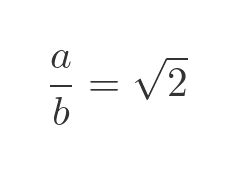
Squaring both sides gives:
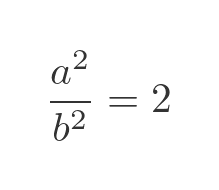
So for root 2 to be rational, there must be integer values a and b such that:
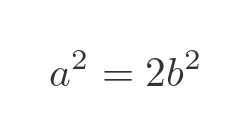
If we can prove that no such integer values can exist, then we have proved that the root of 2 cannot be rational.
An outline of the proof
So, to prove that root 2 is irrational, we just need to prove that this equation cannot be true for any two positive integers a and b:

How does this relate to the carpets theorem? Let's imagine we have a square room of side a. We also have two square carpets of side b. We will choose values of a and b such that the total area of the two carpets is equal to the area of the room. It is always possible to do this, the question is whether we can do it with integer values of a and b.
Let's arrange the two carpets like this:
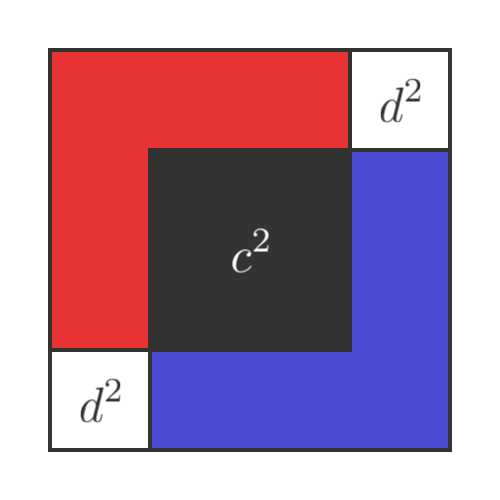
We will make some assumptions, which happen to be true, but we will prove later:
- The carpets overlap.
- The overlapping region is a square (we will call the side c).
- The two uncovered regions are identical squares (we will call the side of each region d).
From the carpets theorem, we know that the overlap area must equal the total of the two uncovered areas, so:
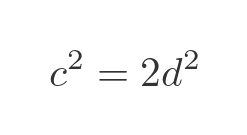
This is interesting, because it is the same formula as we previously had for a and b. We will make two further assumptions (again proved later) that:
- If a and b are positive integers, then c and d will be positive integers.
- c < a and d < b.
Therefore, if a and b are two integers that satisfy the equation, then there must also be two smaller positive integers, c and d, that also satisfy the equation.
We can now apply the same process to c and d, which will create two even smaller positive integers, say e and f, that are also solutions to the equation. But the same logic we used above, we know that e < c and f < d. We can repeat this process indefinitely, each time creating a smaller pair of positive integers.
But that is an impossibility. We cannot have an infinite sequence of positive integer values that continue getting smaller forever. Eventually, the value will reach 1 and can't get any smaller.
This is a contradiction, so a and b cannot both be integers, so the square root of 2 cannot be rational.
Full proof
The proof above is correct, but it makes some assumptions, numbered 1 to 5 above. To complete the proof, we must prove these assumptions.
To help with this, here is a diagram showing the relationship between the measurements:
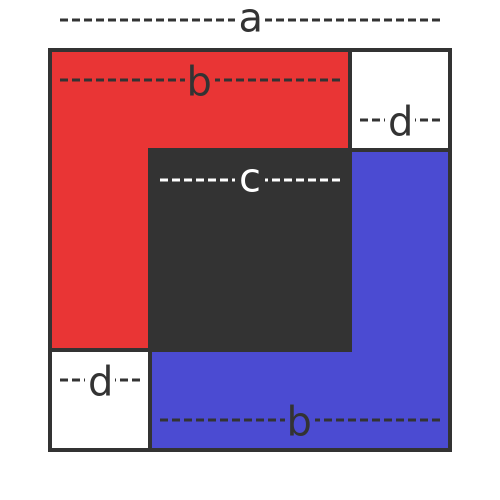
1. Proof that the carpets overlap. The carpets will overlap if the combined widths, b, of the two carpets are greater than the width of the room, a. That is, if:
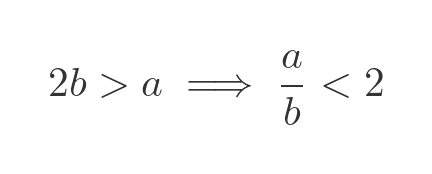
Since a and b are positive (because the width of a room or carpet is always positive), a/b is positive. A positive number that is less than 2 must have a square that is less than 4, so this is equivalent to:

For our proof by contradiction, we are already assuming that:

So the two carpets must overlap.
2 and 3. Proof that the overlap is square, and the two uncovered areas are identical squares. Using the fact that the room and both carpets are square, we can find the measurements in the other direction:
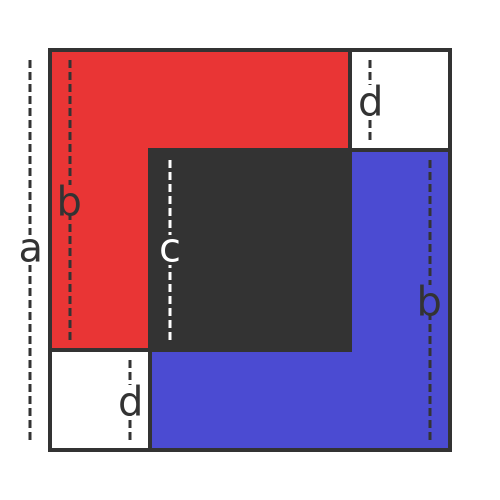
Since the room and carpets are square and have parallel sides, it follows that all the angles in the diagram are right angles. Since the overlap (black) has width and height c, and right-angled corners, it must be square. And since the two uncovered areas (white) each have width and height d, and also right-angle corners, they must be equal squares.
4. Proof that c and d are both positive integers. We can easily prove that they are integers. Side d has length a - b. Since a and b are integers, d must be an integer. Side c has length b - d. Since b and d are integers, c must be an integer.
Is c positive? Well, c is the amount by which the carpets overlap. Provided the carpets overlap, then c is positive. And we know that the carpets overlap from point 1.
d is the width of the gap between one of the carpets and the wall, ie a - b. It will be positive provided b < a. Since the two carpets of side b have the same area as the room of side a, then b must be less than a.
5. c < a and d < b. c is the length of the overlap between the two carpets. The maximum possible value of c, if the carpets overlapped completely, would be b, which is less than a. Therefore, c must be less than a.
d is the height of the non-overlapping part of one of the carpets. The only way d could be greater than or equal to b would be if the carpets didn't overlap at all. But we have shown that the carpets must overlap, therefore d must be less than b.
Related articles

Join the GraphicMaths Newsletter
Sign up using this form to receive an email when new content is added:
Popular tags
adder adjacency matrix alu and gate angle answers area argand diagram binary maths cardioid cartesian equation chain rule chord circle cofactor combinations complex modulus complex numbers complex polygon complex power complex root cosh cosine cosine rule countable cpu cube decagon demorgans law derivative determinant diagonal directrix dodecagon e eigenvalue eigenvector ellipse equilateral triangle erf function euclid euler eulers formula eulers identity exercises exponent exponential exterior angle first principles flip-flop focus gabriels horn galileo gamma function gaussian distribution gradient graph hendecagon heptagon heron hexagon hilbert horizontal hyperbola hyperbolic function hyperbolic functions infinity integration integration by parts integration by substitution interior angle inverse function inverse hyperbolic function inverse matrix irrational irrational number irregular polygon isomorphic graph isosceles trapezium isosceles triangle kite koch curve l system lhopitals rule limit line integral locus logarithm maclaurin series major axis matrix matrix algebra mean minor axis n choose r nand gate net newton raphson method nonagon nor gate normal normal distribution not gate octagon or gate parabola parallelogram parametric equation pentagon perimeter permutation matrix permutations pi pi function polar coordinates polynomial power probability probability distribution product rule proof pythagoras proof quadrilateral questions quotient rule radians radius rectangle regular polygon rhombus root sech segment set set-reset flip-flop simpsons rule sine sine rule sinh slope sloping lines solving equations solving triangles square square root squeeze theorem standard curves standard deviation star polygon statistics straight line graphs surface of revolution symmetry tangent tanh transformation transformations translation trapezium triangle turtle graphics uncountable variance vertical volume volume of revolution xnor gate xor gate